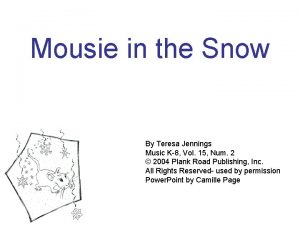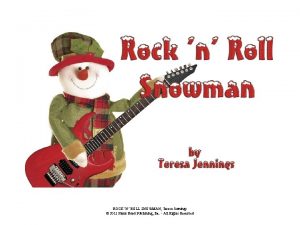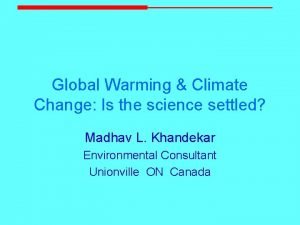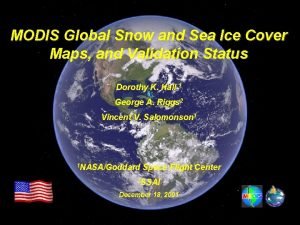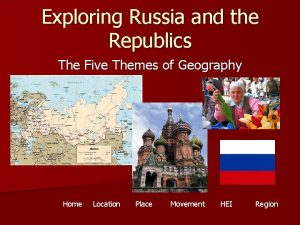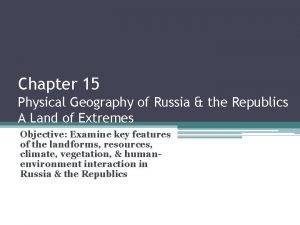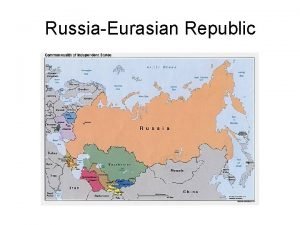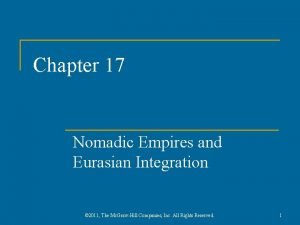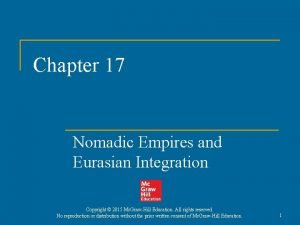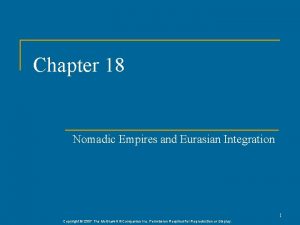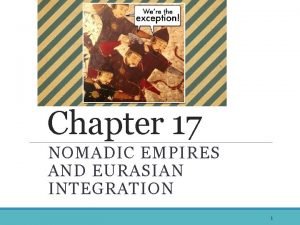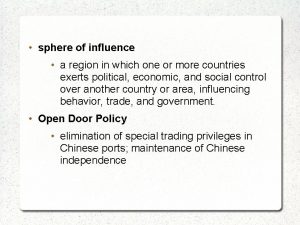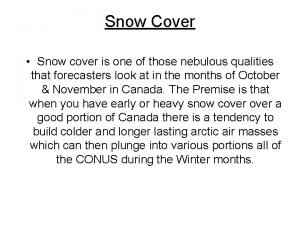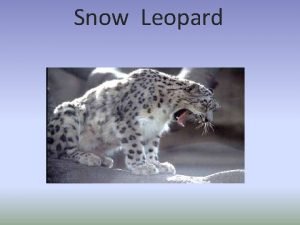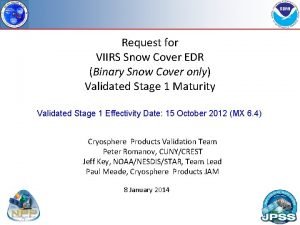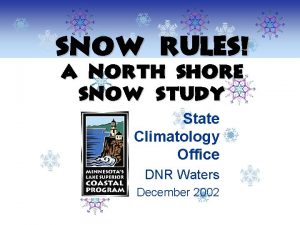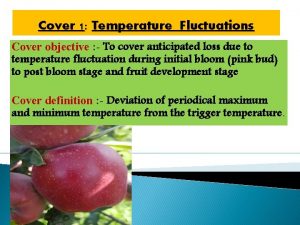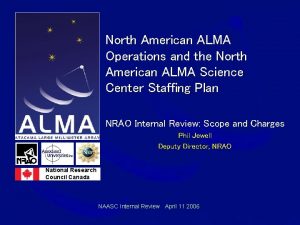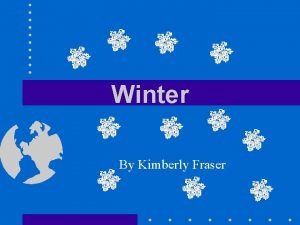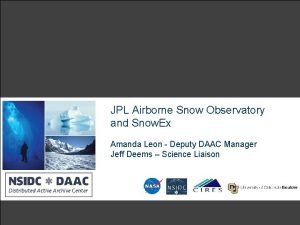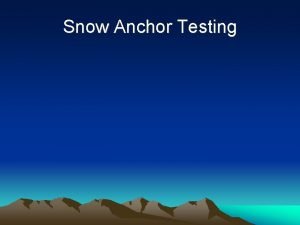Eurasian Snow Cover Influence on North American Winter






















- Slides: 22

Eurasian Snow Cover Influence on North American Winter Temperatures Joshua Coupe

Outline 1. Introduction: the case for a link 2. Data/Methods 3. Results a. SON Eurasian snow cover correlated with DJF North American temperatures b. SON Eurasian snow cover correlated with DJF 500 mb geopotential heights c. Top 5 snowiest Eurasian SON correlated with DJF 500 mb geopotential heights 4. Predictability for 2017

Introduction ● Arctic Oscillation (AO) is the dominant mode of winter variability in the NH ○ ○ associated with the North Atlantic Oscillation (NAO), which influences jet stream over North Atlantic, and most importantly, temperatures. +AO = strong polar vortex; -AO = weak polar vortex ● Mechanisms hypothesized to modulate the AO: ○ ○ North Atlantic SSTs (Rodwell et al 1999; Robertson et al 2000; Hoerling et al 2001) Equatorial Indian Ocean SSTs ( Hurrell et al 2004; Selten et al 2004) Greenhouse gases (Fyfe et al 1999; Osborn 2004; Miller et al 2006) Eurasian snow cover ● Objective: find evidence of Eurasian snow cover inducing AO / NAO circulations

+AO -AO

Why Eurasian Snow Cover? Snow negatively affects a region’s energy balance mostly through albedo changes ● It can also act to modify an air mass ● Polar region circulations are responsible for much of our climate ● Higher than normal snow cover assists in creating very strong high pressure over Siberia ● High pressure can spill over into eastern North America and displace the stratospheric polar vortex. . .

Why Eurasian Snow Cover? Displacement of polar vortex involves a coupling of troposphere and stratosphere in winter. 1) Eurasian snow cover acts as a heat sink, expands Siberian high which influences high latitude Rossby waves formed when air passes over high topography 2) Rossby waves propagate both up and down 3) Coupling between stratosphere and troposphere causes waves to weaken stratospheric polar vortex 4) Weakened stratospheric polar vortex propagates. downward to troposphere, beginning of -AO

Data NH SCE CDR v 01 r 01, a comprehensive northern hemisphere snow cover extent dataset from November 1966 to November 2016 in millions of square kilometers. (Rutgers University Global Snow Lab) GHCN_CAMS Gridded 2 m Temperature, global monthly mean 2 m temperature reanlysis at ½ degree resolution for January 1948 to current. GHCN_CAMS Gridded 500 mb Geopotential Heights, global monthly mean 500 mb geopotential heights reanalysis at 2. 5 degree resolution for January 1948 to November 2016. Time used: SON 1972 through DJF 2016 ( 43 years )

1972 -2015 SON Eurasian Snow Cover Anomaly

Results: SON Eurasian snow cover v. DJF temperature -Low correlations on a point for point basis. -AO / -NAO signals: cold eastern US, warm SE Greenland PNA signals: warm west US, cool eastern US. ? ? ? signals: cold Texas, warm Caribbean.

Results: SON Eurasian snow cover v. DJF 500 mb GH -Low correlations on a point for point basis. (Saito et al. , 2001) found a -. 71 correlation between SON Eurasian snow cover and DJF 500 mb GH across entire NH PNA pattern: deep Aleutian low, ridging in west, trough in east. -AO / -NAO: higher geopotential heights at pole, lower geopotential heights in mid-latitudes (with exception of ridge over western US. ) Eurasian SON Snow Cover and 500 mb Geopotential Height Correlation

Results: SON Eurasian snow cover v. DJF 500 mb GH -Low correlations on a point for point basis. (Saito et al. , 2001) found a -. 71 correlation between SON Eurasian snow cover and DJF 500 mb GH across entire NH PNA pattern: deep Aleutian low, ridging in west, trough in east. -AO / -NAO: higher geopotential heights at pole, lower geopotential heights in mid-latitudes (with exception of ridge over western US. ) Eurasian SON Snow Cover and 500 mb Geopotential Height Correlation

Amplifying the signal: Top 5 snowiest Eurasian autumns ● 1975, 1997, 2001, 2013, 2014 DJF geopotential heights averaged together with hopes to get a stronger signal with the most extreme cases. ● Very strong SE ridge ● High geopotential heights in Arctic, but low height anomalies not as far south. ● Ridging on west coast still present, PNA possibly still in play.

Amplifying the signal: Top 5 snowiest Eurasian autumns ● 1975, 1997, 2001, 2013, 2014 temperature anomalies averaged together with hopes to get a stronger signal with the most extreme cases. ● VERY warm Arctic (>1 SDs) ● Warm/cold lines up with geopotential heights fairly well. ● Very warm North Pacific

Prediction for 2017 Average snow area extent for SON: 13. 066 million km^2 ( +2. 09 SD)

Prediction for 2017 A little late for winter predictions, but here goes nothing.

Prediction for 2017 A little late for winter predictions, but here goes nothing.

Prediction for D 2016 - JF 2017

Prediction for D 2016 - JF 2017

Last year’s prediction? Interesting parallels, but warm ENSO phase dominated temperatures. Average snow area extent for SON: 12. 313 million km^2

Conclusion ● Set out to prove that above average Eurasian snow cover caused an atmospheric response that looked like -AO / -NAO ● Discovered a response that was as much +PNA as -AO ● Anthropogenic climate change may also be complicating things, but I ran out of time to analyze that further.

References Allen, R. J. , Zender, C. S, 2011: Forcing of the Arctic Oscillation by Eurasian Snow Cover. Journal of Climate. , Vol. 24, 6258 -6539. Ambaum, M. , Hoskins, B. , Stephenson, D. Arctic Oscillation or North Atlantic Oscillation, 2001. Journal of Climate, Vol 14. 3495 -3507. Cohen, J. , and M. Barlow, 2005: The NAO, the AO, and global warming: How closely related? J. Climate, 18, 4498– 4513. Cohen, J. , and D. Entekhabi, 1999: Eurasian snow cover variability and Northern Hemisphere climate predictability. Geophys. Res. Lett. , 26, 345– 348. Itoh, H. Reconsideration of the True versus Apparent Arctic Oscillation, 2008. Journal of Climate. Vol 21. 2047 - 2062. Kalnay et al. , The NCEP/NCAR 40 -year reanalysis project, Bull. Amer. Meteor. Soc. , 77, 437 -470, 1996. Kuroda, Y. and Kodera, K. Role of Planetary Waves in the Stratosphere-troposphere Coupled Variability in the Northern Hemisphere Winter, 1999. Geophysical Research Letters, Vol. 26, No. 15, 2375 -2378.

Robinson, David A. , Estilow, Thomas W. , and NOAA CDR Program (2012): NOAA Climate Date Record (CDR) of Northern Hemisphere (NH) Snow Cover Extent (SCE), Version 1. . NOAA National Climatic Data Center. doi: 10. 7289/V 5 N 014 G 9. Saito, K. , and J. Cohen, 2003: The potential role of snow cover in forcing interannual variability of the major Northern Hemisphere mode. Geophysical Research Letters, 30, 1302. Saito, K. , and J. Cohen. , and D. Entekhabi, 2001: Evolution of atmospheric response to early-season Eurasian snow cover anomalies. Monthly Weather Review. , 129, 2746 -2760 Shindell, D. T. , R. L. Miller, G. A. Schmidt, and L. Pandolfo, 1999: Simulation of recent northern winter climate trends by greenhouse-gas forcing. Nature, 399, 452– 455 Wagner, J. A. , 1973: The influence of average snow depth on monthly mean temperature anomaly. Mon. Wea. Rev. , 101, 624 -626 Wallace, J. M. and Gutzler, D. S. , 1981. Teleconnections in the Geopotential Height Field During the Northern Hemisphere Winter. Monthly Weather Review, Vol 109. 784 Wu, Q. , Hu, H. , and Zhang, L. Observed Influences of Autumn-Early Winter Eurasian Snow Cover Anomalies on the Hemispheric PNA-like Variability in Winter, 2011. Journal of Climate, Vol. 24. 2017 -2032.
 Mousie in the snow
Mousie in the snow The rock and roll snowman
The rock and roll snowman Few snow or little snow
Few snow or little snow Winter are snow temperature records
Winter are snow temperature records Winter are snow temperature records
Winter are snow temperature records Snow and ice cover map
Snow and ice cover map Es war eine mutter
Es war eine mutter Winter kommt winter kommt flocken fallen nieder
Winter kommt winter kommt flocken fallen nieder Winter kommt winter kommt flocken fallen nieder lied
Winter kommt winter kommt flocken fallen nieder lied Russia 5 themes of geography
Russia 5 themes of geography Russia and the eurasian republics physical map
Russia and the eurasian republics physical map Russia and eurasian republics
Russia and eurasian republics The mongol empire as a eurasian network
The mongol empire as a eurasian network Chapter 17 nomadic empires and eurasian integration
Chapter 17 nomadic empires and eurasian integration Chapter 17 nomadic empires and eurasian integration
Chapter 17 nomadic empires and eurasian integration Chapter 18 nomadic empires and eurasian integration
Chapter 18 nomadic empires and eurasian integration Chapter 17 nomadic empires and eurasian integration
Chapter 17 nomadic empires and eurasian integration Alternative cover test
Alternative cover test Intermittent exotropia
Intermittent exotropia Worth 4 dot test
Worth 4 dot test Which mcos cover north gsa
Which mcos cover north gsa Lesson 5 american influence grows
Lesson 5 american influence grows Sphere of influence spanish american war
Sphere of influence spanish american war
